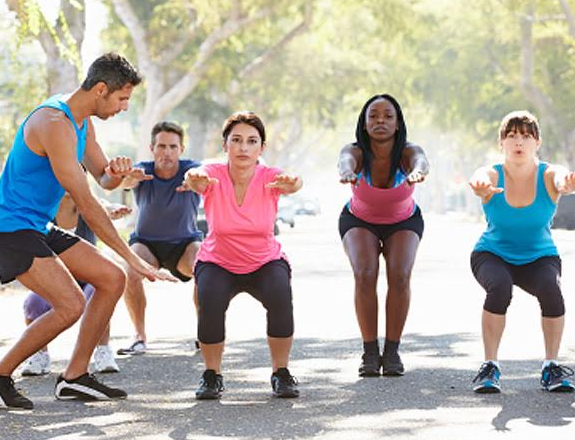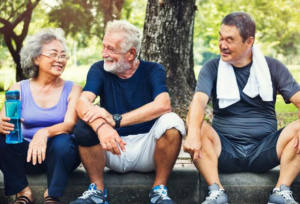Tips for being more active in 2018
As a member of the Academy of Nutrition & Dietetics, I’m privileged to have as colleagues some of the most accomplished Registered Dietitian Nutritionists (RDNs) in the world!
Our guest columnist this week is Mark A. Mahoney, PhD, RDN. Mark has spent his entire professional career working to help improve the health of individuals and communities, beginning in 1975 with a two-and-a-half year stint as an Agricultural Extension Agent/Applied Nutritionist in a small community in northwestern Ecuador, then completing two additional years of Peace Corps service as a Public Health Nutritionist & Health Educator in Chile. He also spent three (3) years working as a Community Health Specialist with an International Non-Governmental Organization (NGO), Project ORBIS, around the world focusing on blindness prevention programs.
individuals and communities, beginning in 1975 with a two-and-a-half year stint as an Agricultural Extension Agent/Applied Nutritionist in a small community in northwestern Ecuador, then completing two additional years of Peace Corps service as a Public Health Nutritionist & Health Educator in Chile. He also spent three (3) years working as a Community Health Specialist with an International Non-Governmental Organization (NGO), Project ORBIS, around the world focusing on blindness prevention programs.

Mark Mahoney
Mark earned his Bachelor’s in Foods & Nutrition from Florida State University in Tallahassee, his Master’s in Nutrition & Public Health from Teachers College of Colombia University, and returned to Tallahassee for his doctorate in International & Comparative Education. Mark recently retired from the Florida Department of Corrections as the Research & Training Specialist for the State of Florida, where he served as the health and wellness expert for a new Departmental initiative, “Wellness Watch.” Mark is a weekly blogger on all things related to health & fitness for the capital city’s newspaper, the Tallahassee Democrat.
Future plans include looking at residing part of the year in Ecuador with periodic visits to Chile, where he has a goddaughter from his time as a Peace Corps Volunteer in that country.
Tips for Being More Active in 2018
By Mark A. Mahoney
As we all age and move into 2018 it would be to our benefit to make a New Year’s resolution, which focuses on becoming more active. Lifestyle choices you make today can lead to a healthier future. Learn how eating a healthy diet and exercising can help control or delay age-related health problems. By following some everyday fitness ideas we can improve our quality of life through promoting a more health-enhancing lifestyle. Four keys to assist us in this aging process include exercises which focus on endurance, strength, balance and flexibility.
Endurance

It’s important to engage in some type of exercise at least three times a week.
Endurance, or aerobic, activities increase your breathing and heart rate. These activities help keep you healthy, improve your fitness, and help you do the tasks you need to do every day. Endurance exercises improve the health of your heart, lungs, and circulatory system. They also delay or prevent many diseases that are common in older adults such as diabetes, heart disease, and osteoporosis.
Try to build up to at least 150 minutes (2 1/2 hours) of moderate endurance activity a week. Being active at least 3 days a week is best. Remember, these are goals. Some people will be able to do more. It’s important to set realistic goals based on your own health and abilities.
When you’re ready to do more, build up the amount of time you spend doing endurance activities first, then build up the difficulty of your activities. For example, gradually increase your time to 30 minutes over several days to weeks by walking longer distances. Then walk more briskly or up steeper hills.
Be aware of some safety tips which include:
- Do a little light activity to warm up and cool down before and after your endurance activities
- Be sure to drink plenty of liquids when doing any activity that makes you sweat
- Dress in layers when exercising outdoors so you can add or remove clothes if you get cold or hot.
Strength
To strengthen your muscles, you need to lift or push weight. Stronger muscles can make it easier to do everyday things like get up from a chair, climb stairs, and carry groceries, open jars, and even play with your grandchildren. Lower-body strength exercises also will improve your balance.

Using weights help to build body strength.
Try to do strength exercises for all of your major muscle groups on 2 or more days per week for 30-minute sessions each, but don’t exercise the same muscle group on any 2 days in a row.
Gradually increase the amount of weight you use to build strength. Start out with a weight you can lift only 8 times. Use that weight until you can lift it easily 10 to 15 times. When you can do 2 sets of 10 to 15 repetitions easily, add more weight so that, again, you can lift it only 8 times.
Repeat until you reach your goal.
Some safety-related tipsto consider include the following:
- Talk with your doctor if you are unsure about doing a particular exercise, especially if you’ve had hip or back surgery
- Don’t hold your breath during strength exercise as holding your breath while straining can cause changes in blood pressure
- Breathe in slowly through your nose and breathe out slowly through your mouth; breathe out as you lift or push, and breathe in as you relax
- To prevent injury, don’t jerk or thrust weights, but use smooth, steady movement
Balance
Each year, more than 2 million older Americans go to the emergency room because of fall-related injuries. Balance exercises can help prevent falls and avoid the disability that may result from falling.

Balance exercises are important for older adults.
You can do balance exercises almost anytime, anywhere, and as often as you like. Also try lower-body strength exercises because they can help improve your balance. Do the lower-body strength exercises 2 or more days a week but not on any 2 days in a row.
Challenge yourself as you progress. Start by holding on to a sturdy chair for support. When you are able, try holding on to the chair with only one hand. With time, hold on with only one finger, then with no hands at all. If you are really steady on your feet, try doing the exercise with your eyes closed.
Some safety tips to consider include:
- Have a sturdy chair or a person nearby to hold on to if you feel unsteady
- Talk with your doctor if you are unsure about doing a particular balance exercise.
Flexibility
Flexibility, or stretching, exercises give you more freedom of movement for your physical activities and for everyday activities such as getting dressed and reaching objects on a shelf. Stretching exercises can improve your flexibility, but they will not improve your strength or endurance.
Do each stretching exercise 3 to 5 times at each session. Slowly and smoothly stretch into the desired position, as far as possible without pain. Hold the stretch for 10 to 30 seconds. Relax, breathe, then repeat, trying to stretch farther.As you become more flexible, try reaching farther in each exercise. But don’t go so far that it hurts.
Consider the following safety tips:
- If you’ve had hip or back surgery, talk with your doctor before doing lower-back flexibility exercises;
- Always warm up before stretching exercises;
- Always remember to breathe normally while holding a stretch; a mild pulling feeling while you are stretching is normal so if you feel sharp or stabbing pain or joint pain, you’re stretching too far and you need to reduce the stretch so it doesn’t hurt;
- Always stretch with a smooth, steady movement and don’t jerk or bounce into the stretch as it may cause injury;
- Avoid “locking” your joints but straighten your arms and legs when you stretch them, but don’t hold them tightly in a straight position.
- Remember to always keep your legs slightly bent while stretching.
For additional details on an exercise and physical activity campaign from the National Institute on Aging at the National Institutes of Health (NIH) NIH that is designed to help you fit exercise and physical activity into your daily life, go to Go4Life at: https://go4life.nia.nih.gov/
_________________
Mark A. Mahoney, Ph.D. has been a Registered Dietitian/Nutritionist for over 30 years and completed graduate studies in Nutrition & Public Health at Columbia University. He can be reached at marqos69@hotmail.com.


















